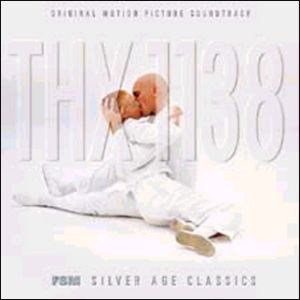************************************************************** EDITOR’s RECOMMENDATION May 2003 **************************************************************
THX1138
Music composed by Lalo Schifrin
FSM Vol 6, No.4
Running time: 55.46
Available from Film Score Monthly, 8503 Washington Boulevard, Culver City, CA90232; Tel: 1-888-345-6335; overseas: 310-253-9595; fax: 310-253-9588; e-mail: Info@filmscoremonthly.com

Logo 0:08
Main Title/What's Wrong? 3:13
Room Tone/Primitive Dance 1:45
Be Happy/LUH/Society Montage 5:05
Be Happy Again (Jingle of the Future) 0:56
Source #1 5:17
Loneliness Sequence 1:27
SEN/Monks/LUH Reprise 2:43
You Have Nowhere to Go 1:10
Torture Sequence/Prison Talk Sequence 3:41
Love Dream/The Awakening 1:46
First Escape 3:01
Source #3 3:33
Second Escape 1:14
Source #4/Third Escape/Morgue Sequence/The Temple/Disruption/LUH's Death 8:29
Source #2 3:16
The Hologram 0:54
First Chase/Foot Chase/St. Matthew Passion (End Credits) 7:40THX1138 is film which came and went with very little notice in 1970 and is today better known of but still very little seen. The film is known of because it is the feature directional debut of the now very famous Star Wars mastermind George Lucas, and it is made all the more potentially interesting to Lucas' fans by virtue of it also being a science fiction film. It is however an example of a very different kind of cinematic SF, the sometimes serious minded often dystopian cinema which flourished between 2001: A Space Odyssey and Planet of the Apes in 1968 and Rollerball (1975) and Logan's Run (1976), before being swept away by Mr Lucas' own most popular work. That said, THX1138 is essentially an arthouse version of the same rebels against a totalitarian regime story which would later power Star Wars, though in this instance told in a tradition stemming from the novels We, Brave New World and 1984.
As such Lalo Schifrin's highly imaginative and inventive score is a galaxy far, far away from John Williams' later work with Lucas. As the very detailed and informative booklet points out, the score can be divided into various sections, delineating them as a) baroque, b) religion, c) alienation, d) the love theme, e) avant-garde and f) source music.
Music in baroque style is used to suggest both the formality of the film's future dictatorship and paradoxically the resilience of the human spirit. For this reason, and connecting with the second grouping, religion, Schifrin utilises part of Bach's St. Matthew's Passion for the climax of the film. The alienation music consists of "low tones, brooding strings" and is the sort of low key underscore which is highly effective in context but which becomes largely unsettling background on disc. The love theme for flute and harp and an Asian musical sensibility occurs four times throughout the score and is appealing in a way which is both tender and yet distant. Strange music consisting of percussion and voices or echo-plexed flute, organ and other miscellany comprise the avant-garde part of the score, while the source music is specially composed muzak in a dumbed-down 1960's jazz idiom. That is apart from one wonderfully banal pop tune "Be Happy Again (Jingle of the Future)".
The result is a very odd and clashing mixture of styles, a dispassionate and dislocated cold nightmare with flashes of humanity seeking light through alienated sound patterns carefully designed to combine with Lucas' formal and precise sound design. It is in its clinical logic a score of which Stanley Kubrick might have approved, representative of an intellectual approach to film music (and film) very much of its time.
It is not music many people are going to find particularly enjoyable for regular listening. It is a fascinating document of a significant experiment in film making. The stereo sound and presentation are superlative. The album deserves to be bought by more than just fanatical Star Wars completists, who will then probably file it never to be played again after one cursory and disgusted listen. An essential addition to the collection of anyone serious about the possibilities of film music as an art.
Gary Dalkin
4
Return to Index